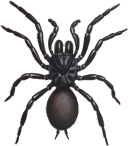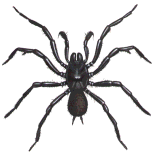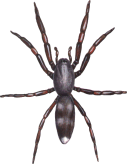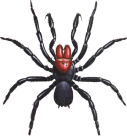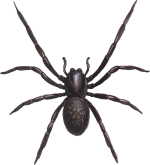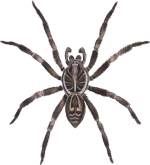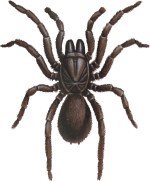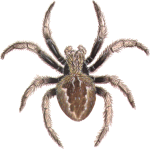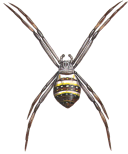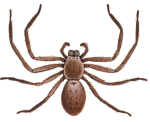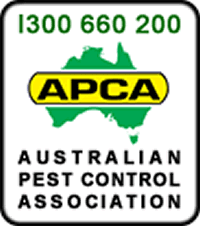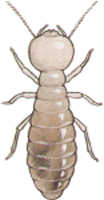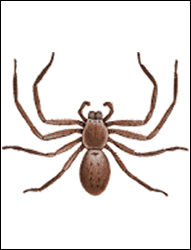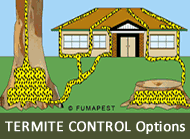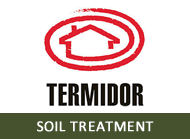| Pest Control for Spiders - Identification & Eradication |
| Spiders commonly found in the Northern Beaches Region |
FUMAPEST Advice on Spider identification, eradication and control - apply online for a Spider Identification Chart of Spiders commonly found in the Northern Beaches Region - notes about their usual habitat areas - the recommended safe and effective methods of pest control for spiders - and the FIRST AID procedures for spider bite victims.
|
|
|||||||||||||||||||||||||||||||||||
| Sydney Funnel-Web spiders: aggressive by nature - can be deadly |
|
Area of distribution: The Sydney Funnel-Web Spider is a ground dweller, commonly found in moist soil areas along much of the eastern coastal area of New South Wales and Victoria.
Venom toxicity: The Sydney Funnel-Web Spider is one of the world's most deadly spiders. Both the male and female carry atraxotoxin, one of the world's most dangerous toxins. DANGER TIME: The mature male Sydney funnel-web spider will leave it's burrow and wander off during hot humid nights, looking for a mate. At this time it is known to enter homes, lodge in footwear, clothing and swimming pools, where they can survive several days under water. Highly aggressive: The male Sydney funnel web spider is highly aggressive when disturbed or cornered and is able to inflict multiple bites, with its "flick-knife" hardened fangs. Heavy rain or earthworks will drive the Sydney funnel-web spider out of it's burrow and are commonly found wandering around the garden or in the home at such times. An anti-venom is available in most major hospitals and ambulance vehicles in "funnel-web country". If bitten, you should apply first aid and medical attention (ambulance) should be sought as soon as possible. Spider identification: The male Sydney funnel-web spider is about 25 mm and the female about 30 mm in body length. They are shiny black in colour with a dark purplish brown abdomen with a covering of reddish hairs. Unique identification markings include it's long spinnerets, that is, the two appendages on the end of the abdomen. Also the male Sydney funnel-web spider has a distinctive spur on both it's second front legs - refer to illustration on left. The Blue Mountains funnel-web spider is highly venomous and is found in the Blue Mountains area, as far west as the Bathurst - Orange region and occasionally in the Sydney basin. The Northern tree funnel-web spider is highly venomous and is found in south-eastern Queensland and northern New South Wales as far south as the Hunter Valley region. Click here re FIRST AID for Sydney Funnel-web spider bite |
||||
| Red-Back spiders - highly venomous - can be deadly |
|
Area of distribution: Australia-wide.
Venom toxicity: The Red-Back spider can inflict a painful bite which can be fatal, especially to the young and elderly. An effective anti-venom was developed in 1956. About 250 people receive the anti-venom each year. Nerve poison: Only a small amount of venom can cause serious illness, as the poison attacks the nervous system. Systemic envenomisation usually results in headache, nausea, vomiting, abdominal pain, pyrexia, hypertension and in severe cases, paralysis. Excruciating pain: The pain around the spider bite area can be excruciating. If bitten, immediately apply first aid and seek medical attention (ambulance) should be sought as soon as possible. Spider Identification: The red-back spider size varies greatly. The male can be tiny, with the abdomen of the female growing to the size of a large pea. Red-back spiders do NOT always have a "red" marking. Habitat: The red-back spider prefers dry habitats; is often found in out-houses, letter-boxes, underside of seats, in rubbish, such as empty cans, in the sub-floor and other dark areas. Electric lights attract their prey, such as moths, flies, mosquitoes and other insects. Click here re FIRST AID for a Red-back spider bite |
||||
| White-tail spiders: venomous and highly dangerous ? |
|
Area of distribution: Australia-wide.
Venom toxicity: The bite of a white-tail spider may cause nausea and burning pain followed by swelling and itchiness around the site of the bite. In some rare but dramatic cases, a severe allergic reaction, blistering or ulceration of the skin, similar to gangrene, has apparently been caused by a white-tail spider bite. Proven dangerous? Some scientific researchers are unconvinced as to whether this spider causes such horrific ulcerations. Bacterial infection of the wound caused by Mycobacterium ulcerans carried on the fangs of the white-tail spider, may be a contributory factor. In any case first aid and medical attention should be sought, if bitten, as and when any adverse health effects are observed. Spider identification: The adult white-tail spider adult varies in size from 12 to 20 mm in body length; is grey to black in colour with a white section on the end of it's tail - as illustrated. Habitat: The white-tail spider prefers cool moist locations and is commonly found in garden mulch areas. In summer, it often wanders into buildings, particularly bathrooms, to escape the heat. Click here re FIRST AID for White-tail spider bite |
||||
| Mouse spiders - venomous, painful bite |
|
Area of distribution: Australia-wide.
Venom toxicity: The Mouse spider is known to cause severe illness, especially to young children. Although normally not aggressive, the male Mouse spider will bite if provoked, and should be considered dangerous to humans. Deep painful bite: The Mouse spider has large hard fangs which can cause a deep painful bite. First aid and medical attention (ambulance) should be sought as soon as possible. Spider Identification: The Mouse spider is a medium to large spider of up to 35 mm in body length. The male Mouse Spider may or may not have a bright red head and elongated fangs. Mistaken identity: The Mouse spider is often mistaken for the Sydney funnel-web spider. The main differences being the funnel-web spider has far longer spinnerets (the 2 appendages on the end of the abdomen) and the male funnel-web has a spur on each of it's second leg - as illustrated above. Habitat: Mouse spiders are ground dwellers with burrows that may be more than one metre deep. The male Mouse spider often wanders about during the day on open ground, especially after rain, in search of a female. Click here re FIRST AID for a Mouse spider bite |
||||
| Black House spiders ...venomous, causes nausea |
|
Area of distribution: Australia-wide.
Venom toxicity: The bite of the Black House Spider is poisonous but not lethal. Some people report severe pain around the bite site, heavy sweating, muscular pains, vomiting, headaches and giddiness. In any case if bitten by a Black-house spider, immediate first aid and medical attention (ambulance) should be sought. Spider Identification: The adult Black House spider spins a lacy, messy web and are up to 15 mm in body length and of a dark brown to black velvet textured appearance. Habitat: The Black House spider and prefers dry habitat areas and secluded locations, and is commonly found in window framing, under eaves, gutters, in brickwork, sheds, toilets and among rocks and bark. Electric lights attract their main food source of moths, flies, mosquitoes and other insects. Click here re FIRST AID for a Black House Spider Bite |
||||
| Wolf spiders ...venomous but non-aggressive |
|
Area of distribution: Australia-wide.
Venom toxicity: The bite of the Wolf Spider is poisonous but not lethal. Although non-aggressive, they will bite if provoked and should be considered dangerous to humans. Painful bite: The bite may be very painful. Immediate first aid and medical attention, particularly as to children or the elderly. Spider Identification: The adult Wolf spider is 15 mm to 30 mm in body length; of mottled grey to brown in colour, with a distinct Union Jack impression on it's back. The female Wolf spider carries it's young on it's back. Habitat: The Wolf spider is a ground dweller, with a burrow retreat. This spider has a roving nocturnal lifestyle to hunt their prey and can move very rapidly when disturbed. Commonly found around the home, in garden areas with a silk lined burrow, sometimes with a lid or covered by leaf litter or grass woven with silk as a little fence around the rim of the burrow. Click here re FIRST AID for a Wolf spider bite |
||||
| Trap-Door spiders ... low risk and non-aggressive |
|
Area of distribution: Australia-wide.
Venom toxicity: The bite of the Trap-Door spider is of low risk (mildly toxic) to humans. It is a usually timid and non-aggressive spider but may stand up and present it's fangs if harassed. Rarely bites but if it does bite you it can be painful. Spider Identification: The adult Trap-door spider is about 35 mm in body length; of brown to dark brown in colour; and heavily covered with fine hairs. The male has distinct boxing glove-shaped palps, that is the two "sensory feelers" at front of it's head. Habitat: The Trap-door spider is a ground dweller, with a burrow retreat lined with silk of up to 250 mm in depth and around 25 mm in width. The Trap-door spider prefers nesting in drier exposed locations, and may have a wafer-like lid on the burrow entrance. Click here re FIRST AID for a Trap-door spider bite |
||||
| Orb-Weaving spiders ... low risk and non-aggressive |
|
Area of distribution: Australia-wide, particularly common in bush land along the eastern coastal areas.
Venom toxicity: The bite of an Orb-Weaving spiders is of low risk (mildly toxic) to humans. Orb-Weaving spiders are a non-aggressive group of spiders. Seldom bite. Be careful not to walk into their webs at night - the fright of this spider crawling over one's face can be terrifying and may cause a heart attack, particularly to the susceptible over 50 year olds. Spider Identification: The adult Orb-Weaving spiders is about 20 to 30 mm in body length; has a bulbous abdomen; and often has a colorful, dark to light brown pattern. The common Golden Orb-Weaver spider has a purplish bulbous abdomen with fine hairs. Habitat: Garden orb-weaving spiders are oten found in summer in garden areas around the home. They spin a large circular web of two metres or more, often between buildings and shrubs, to snare flying insects, such as flies and mosquitoes. Click here re FIRST AID for Orb-weaving spider bite |
||||
| St Andrews Cross spiders ... low risk and non-aggressive |
|
|
|
Venom toxicity: the bite of the St Andrews Cross is of low risk (non-toxic) to humans. They are a non-aggressive group of spiders.
Area of distribution: Australia-wide. Spider Identification: adult 5 to 15 mm in body length - abdomen striped yellow and brown - as illustrated. The St Andrews Cross Spider usually sits, upside down, in the middle of it's web forming a cross - as illustrated. Habitat: this spider is a web-weaver usually found in summer in garden areas around the home. It is considered beneficial as it spins a large web to snare flying insects, such as flies and mosquitoes. Click here re FIRST AID for a Andrews Cross Spider Bite |
|||
| Huntsman spiders ...low risk and non-aggressive |
|
Area of distribution: Australia-wide.
Venom toxicity: The bite of Huntsman spiders is of low risk (mildly toxic) to humans. Huntsman spiders are a non-aggressive group of spiders. Painful bite: a large Huntsman spider has extended fangs and can deliver a deep painful bite. Howver they are extremely timid and will run away given the chance. Beware in summer when the female Huntsman spider is guarding her egg sacs or young. Spider Identification: An adult Huntsman spider may have a body length of up to 20 mm. It's the diameter including legs may reach 45 mm. The first 2 pairs of legs are longer than rear two. The Huntsman spider is hairy; buff to beige brown colour, with dark patches on it's body. Usual habitat areas: The Huntsman spider prefers to live under the flaking bark of trees, under flat rocks and under eaves or within roof spaces of buildings. Often found indoors: The Huntsman Spider often wanders into homes and is found perched on a wall. They are shy, timid spiders able to move sideways at lighting-fast speed. Click here re FIRST AID for a Huntsman Spider Bite |
||||
| About FUMAPEST Termite & Pest Control MANLY ... our credentials |
|
|||||||||||||||
| WARNING: The NSW Govt EPA Pest Control Licensing is INADEQUATE |
The NSW Pest Control Licensing system is subject to National Competency Assessment guidelines. Mediocre testing can be carried by Private Workplace Assessors (not part of TAFE system). The so called competency assessment can be a combination of oral, written and visual tests. Private Workplace Assessors are given general guidelines in the National Competency Standards but there is no set standard test or specific knowledge requirements. Once privately assessed as "competent" then the NSW Govt EPA Pest Control Licensing will issue a pest control licence to the individual. There is no published list of Private Workplace Assessors.. The System is Inadequate: Some Private Assessors offer a one week course. A person so issued with a pest control licence can set up a Pest Control business (not required to register with EPA Licensing Authority and employ many trainees, using pesticides in people's homes without direct personal supervision. FUMAPEST Setting the Standard in an industry plagued by fly-by-night operators, FUMAPEST Termite & Pest Control stands out as a well established pest control business with excellent reputation in the market-place. Same Family Business • Since 1964 • Termite & Pest Control Specialists. |
||||||||||||||||
| FUMAPEST Termite & Pest Control ... services we offer |
Commercial Food Premises • FUMAPEST MANLY Pest Control is compliant with Food Act NSW & HACCP requirements for commercial food handling premises in MANLY Council Region • restaurants • cafes • bakeries • backpacker hostels • child care centres • churches • factories • health care facilities • hospitals • hotels • motels • nursing homes • offices • racehorse stables • retirement villages • schools • colleges • veterinary clinics • other sensitive environments • click here for more details. Termite Control Specialists • AS.4349 Termite Inspection Reports • Termite Baiting • Termite Colony Elimination • Exterra termite bait • Nemesis termite bait • Sentricon termite bait • AS3660 Termite Preventive Barriers • Termiticides • Altriset • Termidor fipronil • Premise imidacloprid • click here for more details. KORDON Termite Barrier for Builders • Manufactured by Bayer Australia • FUMAPEST Termite & Pest Control are Licensed KORDON Installers for building constructions in the MANLY Council Region • KORDON is CodeMark Accredited and meets Australian Building Code and MANLY Council termite control requirements for buildings under construction • a 10 year warranty applies backed by Bayer • click here for more details. Professionally Trained Technicians • The FUMAPEST Termite & Pest Control Training Program regularly assesses and updates technician skills in the use of latest generation products and our EcoSafe Pest Control systems • all termite control technicians have the APCA or TAFE Pest Control Certificate • NSW Govt EPA Pest Control Licence • and many years field-work experience in termite control. |
||||||||||||||||||||||||
| FUMAPEST Termite & Pest Control services the MANLY Council Region |
